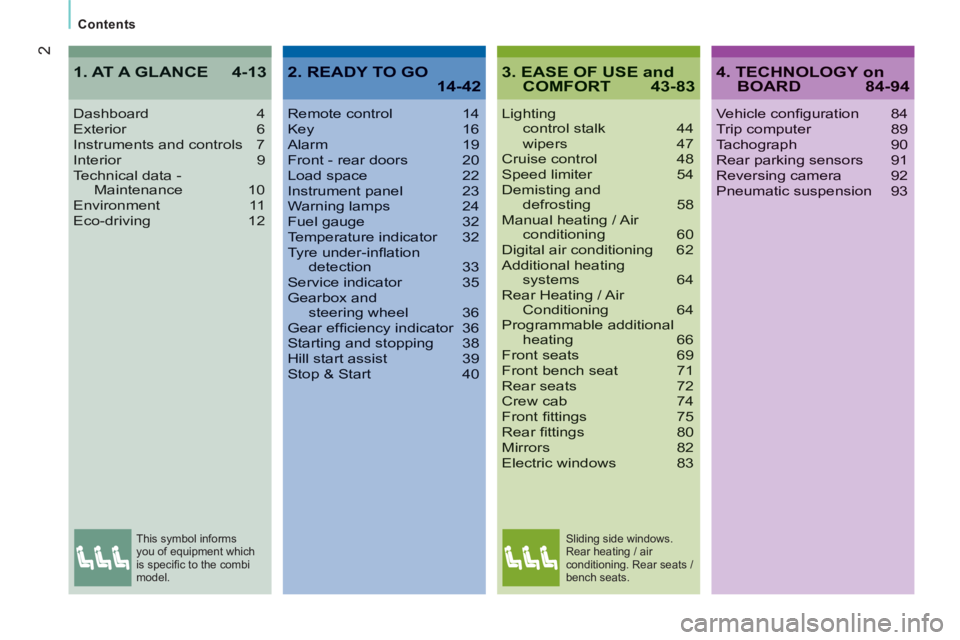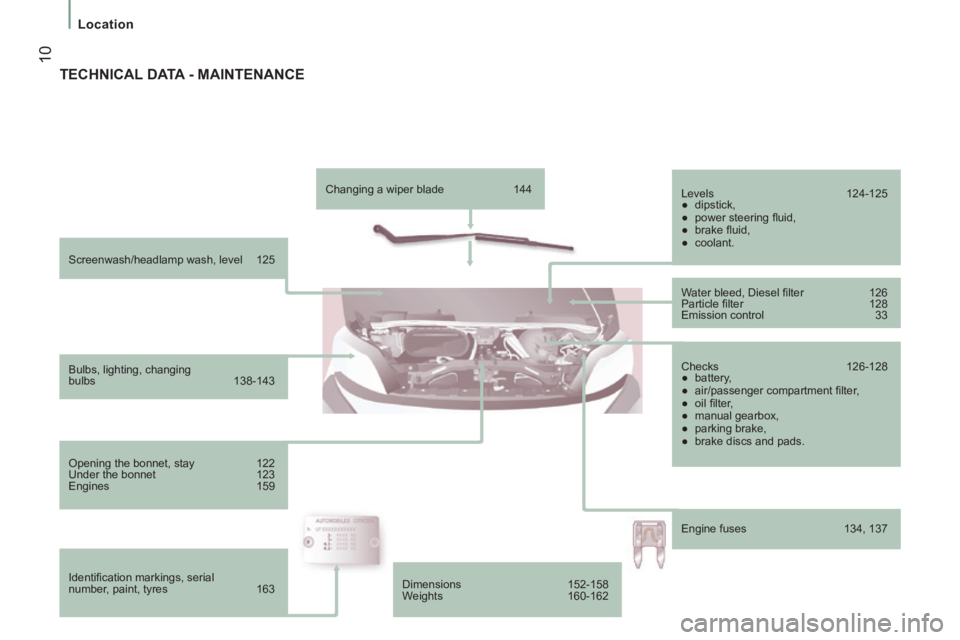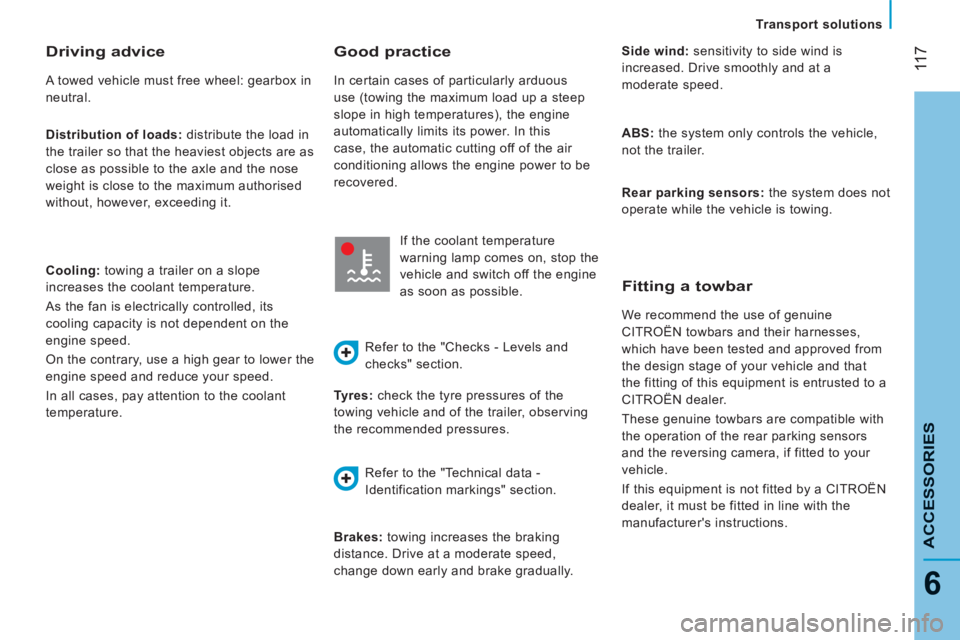technical data CITROEN RELAY 2015 Handbook (in English)
[x] Cancel search | Manufacturer: CITROEN, Model Year: 2015, Model line: RELAY, Model: CITROEN RELAY 2015Pages: 248, PDF Size: 8.86 MB
Page 4 of 248

2
Contents
3. EASE OF USE and COMFORT 43-83
Lighting control stalk 44 wipers 47Cruise control 48Speed limiter 54Demisting and defrosting 58Manual heating / Air conditioning 60Digital air conditioning 62Additional heating systems 64Rear Heating / Air Conditioning 64Programmable additional heating 66Front seats 69Front bench seat 71Rear seats 72Crew cab 74Front fi ttings 75Rear fi ttings 80Mirrors 82Electric windows 83
Dashboard 4Exterior 6Instruments and controls 7Interior 9Technical data - Maintenance 10Environment 11Eco-driving 12
1. AT A GLANCE 4-134. TECHNOLOGY on BOARD 84-94
Vehicle confi guration 84Trip computer 89Tachograph 90Rear parking sensors 91Reversing camera 92Pneumatic suspension 93
2. READY TO GO 14-42
Remote control 14Key 16Alarm 19Front - rear doors 20Load space 22Instrument panel 23Warning lamps 24Fuel gauge 32Temperature indicator 32Tyre under-infl ation detection 33Service indicator 35Gearbox and steering wheel 36Gear effi ciency indicator 36Starting and stopping 38Hill start assist 39Stop & Start 40
This symbol informs
you of equipment which
is specifi c to the combi
model. Sliding side windows.
Rear heating / air
conditioning. Rear seats /
bench seats.
Page 5 of 248

3
Contents
CONTENTS
5. SAFETY 95-1156. ACCESSORIES 116-120
7. CHECKS 121-130
8. QUICK HELP 131-151
9. TECHNICAL DATA152-164
Parking brake 95Hazard warning lamps 95Horn 96Braking assistance systems 96Trajectory control systems 98Lane departure warning system 101Seat belts 102Airbags 105Deactivating the passenger's front airbag 106Child seats 108ISOFIX seats 112
Towing a trailer 116Roof carrying systems 118Other accessories 119Snow chains 120
Opening the bonnet 122Under the bonnet 123Levels 124Checks 126Fuel 129
Battery 131Changing a fuse 134Changing a bulb 138Changing a wiper blade 144Changing a wheel 145Puncture repair kit 148Towing the vehicle 150
Dimensions 152Engines 159Weights 160Identifi cation markings 163
10. AUDIO and TELEMATICS
TOUCH SCREEN AUDIO-TELEMATIC system 10.1AUDIO system 10.51
Child seats in the rear.
Page 12 of 248

10
Location
Screenwash/headlamp wash, level 125
Bulbs, lighting, changing
bulbs 138-143
Opening the bonnet, stay 122
Under the bonnet 123
Engines 159
Identifi cation markings, serial
number, paint, tyres 163 Changing a wiper blade
144
Levels 124-125
● dipstick,
● power steering fl uid,
● brake fl uid,
● coolant.
Water bleed, Diesel fi lter 126
Particle fi lter 128
Emission control 33
Checks 126-128
● battery,
● air/passenger compartment fi lter,
● oil fi lter,
● manual gearbox,
● parking brake,
● brake discs and pads.
Engine fuses 134, 137
TECHNICAL DATA - MAINTENANCE
Dimensions 152-158
Weights 160-162
Page 35 of 248

33
2
READY TO GO
Instruments and controls
EMISSIONS CONTROLS
EOBD (European On Board Diagnosis) is
a diagnostics system which complies with,
among others, the standards concerning
authorised emissions of:
- CO (carbon monoxide),
- HC (unburnt hydrocarbons),
- NOx (nitrous oxides) or particles, detected by oxygen sensors placed
upstream and downstream of the
catalytic converters.
TYRE UNDER-INFLATION DETECTION
System which automatically checks the
pressures of the tyres while driving.
The tyre under-inflation detection
system is an aid to driving which does
not replace the need for the driver to be
vigilant or to drive responsibly. This system does not avoid the need
to check the tyre pressures regularly
(including the spare wheel) and before a
long journey.
Driving with under-inflated tyres adversely
affects road holding, extends braking
distances and causes premature tyre
wear, particularly under arduous conditions
(vehicle loaded, high speed, long journey).
Driving with under-inflated tyres
increases fuel consumption.
The system continuously monitors the
pressures of the four tyres, as soon as the
vehicle is moving.
A pressure sensor is located in the valve of
each tyre (except the spare wheel).
The system triggers an alert if a drop in
pressure is detected in one or more tyres. The tyre pressures must be checked
when the tyres cold (vehicle stopped
for 1 hour or after driving for less then
6 miles (10 km) at moderate speed).
Otherwise, add 0.3 bar to the values
indicated on the label.
The tyre pressures for your vehicle can be
found on the tyre pressure label.
The driver is warned of any
malfunction of this emission
control system by the illumination
of this specific warning lamp in
the instrument panel.
There is a risk of damage to the catalytic
converter. Have it checked by a CITROËN
dealer or a qualified workshop.
Refer to the "Technical data -
Identification markings" section.
Page 118 of 248

11 6
Transport solutions
TOWING A TRAILER...
The type-approved towable weights are
entered in your vehicle's registration
certificate, as well as on the manufacturer's
VIN plate. These weights are also given in sales
brochures.
You will then have information on your
vehicle's ability to tow a trailer, a caravan,
a boat...
Refer to the "Technical data - Vehicle
identification" section. For the maximum unbraked trailer
weight and the recommended nose
weight, refer to the "Technical data -
Weights" section.
Page 119 of 248

11 7
6
Transport solutions
ACCESSORIES
Distribution of loads: distribute the load in
the trailer so that the heaviest objects are as
close as possible to the axle and the nose
weight is close to the maximum authorised
without, however, exceeding it.
Driving advice
A towed vehicle must free wheel: gearbox in
neutral.
Cooling: towing a trailer on a slope
increases the coolant temperature.
As the fan is electrically controlled, its
cooling capacity is not dependent on the
engine speed.
On the contrary, use a high gear to lower the
engine speed and reduce your speed.
In all cases, pay attention to the coolant
temperature. Tyres: check the tyre pressures of the
towing vehicle and of the trailer, observing
the recommended pressures.
Fitting a towbar
We recommend the use of genuine
CITROËN towbars and their harnesses,
which have been tested and approved from
the design stage of your vehicle and that
the fitting of this equipment is entrusted to a
CITROËN dealer.
These genuine towbars are compatible with
the operation of the rear parking sensors
and the reversing camera, if fitted to your
vehicle.
If this equipment is not fitted by a CITROËN
dealer, it must be fitted in line with the
manufacturer's instructions.
Good practice
In certain cases of particularly arduous
use (towing the maximum load up a steep
slope in high temperatures), the engine
automatically limits its power. In this
case, the automatic cutting off of the air
conditioning allows the engine power to be
recovered.
If the coolant temperature
warning lamp comes on, stop the
vehicle and switch off the engine
as soon as possible.
Refer to the "Checks - Levels and
checks" section.
Brakes: towing increases the braking
distance. Drive at a moderate speed,
change down early and brake gradually. Side wind: sensitivity to side wind is
increased. Drive smoothly and at a
moderate speed.
ABS: the system only controls the vehicle,
not the trailer.
Rear parking sensors: the system does not
operate while the vehicle is towing.
Refer to the "Technical data -
Identification markings" section.
Page 120 of 248

11 8
Transport solutions
ROOF CARRYING SYSTEMS
Refer to the "Technical data -
"Dimensions" section for more
information on the length (L1 to L4) and the
height (H1 to H3) of the vehicle. Maximum load on the roof, evenly
distributed: 150 kg, for all versions,
within the vehicle's weight limit (Gross
Vehicle Weight).
For reasons of safety and to avoid damaging
the roof, it is essential to use a carrying
system (roof bars or roof rack) that is
approved for your vehicle.
Roof bars can only be fitted to H1 height
van, combi and minibus versions. On a
minibus, check for the presence of roof air
conditioning units.
TOWBAR WITH QUICKLY
DETACHABLE TOW BALL
This tow ball can be fitted and removed
quickly and easily without the use of tools.
When not towing a trailer, remove the
quickly-detachable tow ball before driving. Never exceed the maximum authorised
weight for the vehicle plus trailer
(Gross Train Weight - GTW).
For information on the maximum
trailer weight and the recommended
nose weight, refer to the "Technical data -
Weights" section. The carrying system must always be
secured to the fitting points provided on the
vehicle's roof: 6, 8 or 10, depending on the
wheelbase of the vehicle.
Observe the instructions for fitting and use
provided with the carrying system.
Observe in full the legal requirements
related to carrying outsized loads.
Page 149 of 248

147
QUICK HELP
8
Puncture
Refitting the repaired wheel
Refitting the repaired wheel is the same as
fitting the spare wheel; don't forget to refit
the wheel trim. Refer to the "Technical data -
Identification markings" section for the
location of the tyre pressure label.
The spare wheel is not designed to be used
over long distances. Have the tightening of
the bolts and pressure of the spare wheel
checked by a CITROËN dealer or a qualified
workshop without delay.
Also, have the original wheel repaired and
refitted by a CITROËN dealer or a qualified
workshop as soon as possible.
Fitting the spare wheel
- Put the spare wheel in place on the hub and start screwing in the bolts by hand.
- Carry out an initial tightening of the bolts using the wheelbrace E .
- Lower the vehicle completely by folding the jack, then remove the jack.
- Tighten the bolts again using the wheelbrace E , tighten them fully without
forcing them.
- Stow the wheel to be repaired at the rear of the vehicle. - Hook the support H
and screw in the
handle G .
- Insert the long socket A in the hole then
wind the bolt fully, using the ratchet
wrench B , to raise the wheel.
- Stow the tools and the trim.
If you have a retractable foot board, the jack
must be positioned at 45°.
- Extend the jack using the ratchet wrench B until the wheel is a
few centimetres off the ground.
- Unscrew the bolts fully and remove the wheel to be repaired.
Page 155 of 248

153
9
TECHNICAL DATA
Dimensions
DIMENSIONS
Your vehicle is available in 4 lengths (L1...) and 3 heights (H1...),\
refer to the corresponding tables: VA N
L1 L2 L3 L4
H1 H2 H1 H2 H2 H3 H2 H3
L Overall length 4 963 5 413 5 998 6 363
H Overall height 2 254 2 524 2 254 2 524 2 524 2 764 2 524 2 764
A Wheelbase 3 000 3 450 4 035
B Front overhang 948
C Rear overhang 1 015 1 380
D Overall width (incl./excl. mirrors) 2 508 / 2 050
E Width of front track 1 810
F Width of rear track 1 790
G Height of load floor 535 to 565
I Length of interior floor 2 670 3 120 3 705 4 070
J Maximum interior load height 1 662 1 932 1 662 1 932 1 932 2 172 1 932 2 172
K Maximum interior width 1 870
M Interior width between wheel arches 1 422
Volume (m
3 ) 8 9.5 10 11.5 13 15 15 17
Page 157 of 248

155
9
TECHNICAL DATA
Dimensions
SIDE DOOR
L1 L2 L3 L4
H1 H2 H1 H2 H2 H3 H2 H3
P Height of the sliding side door 1 485 1 755 1 485 1 755
Q Width of the sliding side door 1 075 1 250